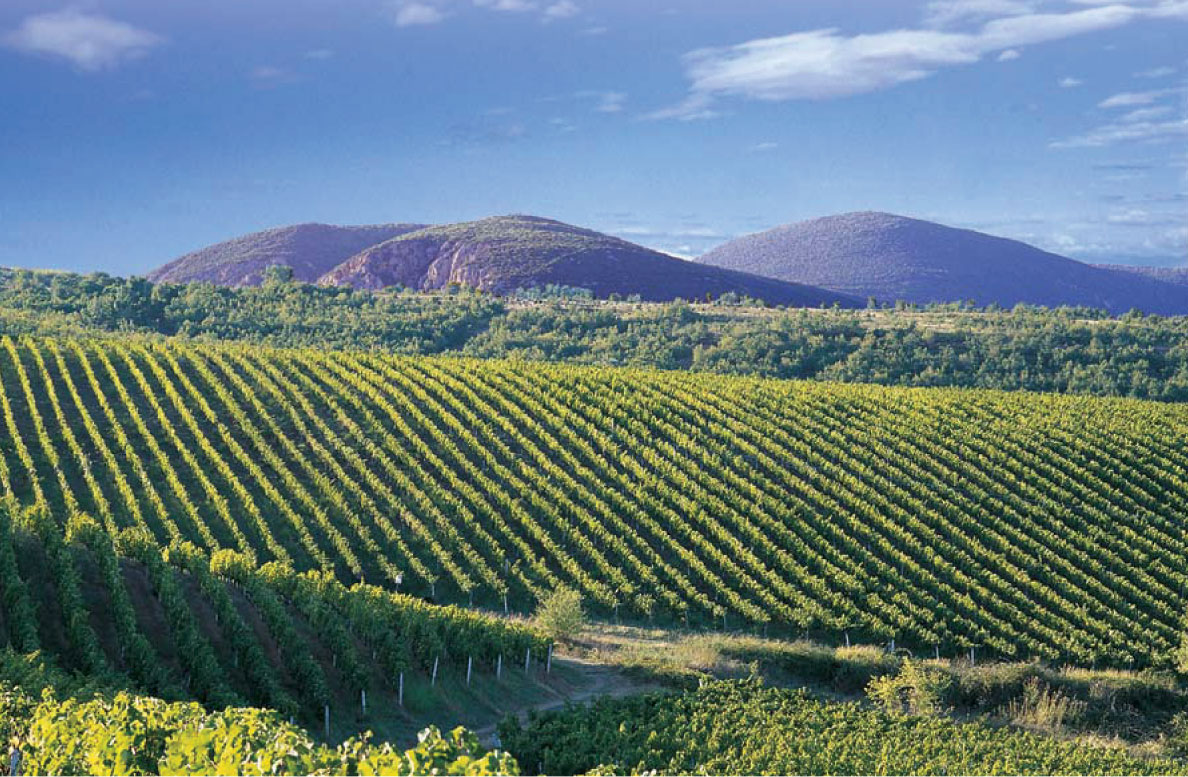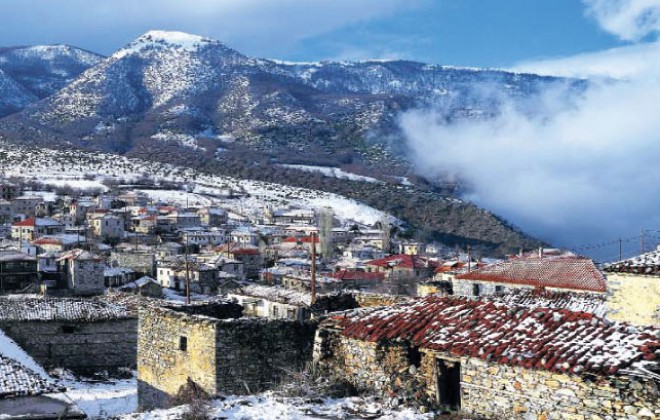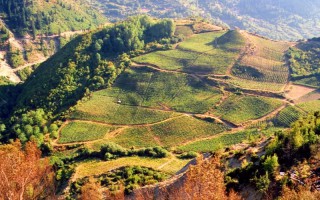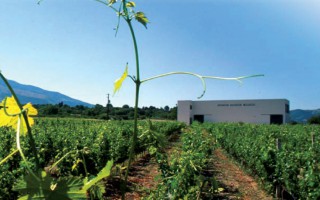 The Wine Route of Goumenissa – Pella, geographically belongs to the Prefectures of Kilkis and Pella and involves the vinicultural regions of Goumenissa and Giannitsa.The wineries of this area are the following: The winery of Tatsis Family, Vaggelis Chatzivaritis and the Boutari Winery in Goumenissa.
The Wine Route of Goumenissa – Pella, geographically belongs to the Prefectures of Kilkis and Pella and involves the vinicultural regions of Goumenissa and Giannitsa.The wineries of this area are the following: The winery of Tatsis Family, Vaggelis Chatzivaritis and the Boutari Winery in Goumenissa.
![]() Goumenissa is a small picturesque town situated at the foot of mount Paiko (1650m.) and was formerly an important commercial center due to the viniculture and the sericulture. There are several writings speaking of its fine red dry wines, which have been exported since the 19th century. Nowadays the city`s population is 4.200 inhabitants and the vineyard has been restricted to 250ha. Goumenissa is one of the A.O.C. greek zones producing red dry wines from the red grape varieties Xynomavro and Negoska. Another white grape variety cultivated in the Goumenissa region is Roditis.
Goumenissa is a small picturesque town situated at the foot of mount Paiko (1650m.) and was formerly an important commercial center due to the viniculture and the sericulture. There are several writings speaking of its fine red dry wines, which have been exported since the 19th century. Nowadays the city`s population is 4.200 inhabitants and the vineyard has been restricted to 250ha. Goumenissa is one of the A.O.C. greek zones producing red dry wines from the red grape varieties Xynomavro and Negoska. Another white grape variety cultivated in the Goumenissa region is Roditis.

The discovery of places, flavors and aromas continues west, to the Aridaia region and the villages around the Kaimaktsalan ski centre before heading to the valley of Pella. Picturesque hotels, cosy tavernas, traditional shops and outdoor leisure activities await visitors along the route.
An interesting suggestion is visiting the area on St.Trifonas` day (February 1st) to witness the happenings on the occasion of the celebration in memory of the patron saint of viniculture.
Other places of interest worth a visit are:
-The traditional mountainous settlement of Kastaneri, in Paiko
-Kilkis (archaeological museum, folklore museum, war museum, museum of natural history)
-The folklore museum of Goumenissa
-The Holy Monastery of Virgin Mary in Goumenissa
-The Holy Monastery of St. Nikodimos, Pentalofos in Goumenissa
-The Holy Monastery of St. Rafail, Grivas-Pella (archaeological site and museum)
Source: www.wineroads.gr
: Visitable Wineries: Remarkable visited sites
 From the shorefront of the Thermaikos bay to high up on the mountains of the region and back down to the plains, the area of Thessaloniki is home of many famous wines. In the mountainous parts of the region, on the southeast slope of Vertiskos, just before the traditional settlement of Ossa, the vineyards are stretched amidst clumps of oak, beech and chestnut trees. Alongside the vineyards, sites of archeological interest, exquisite churches, monasteries and museums await for the demanding traveller.
From the shorefront of the Thermaikos bay to high up on the mountains of the region and back down to the plains, the area of Thessaloniki is home of many famous wines. In the mountainous parts of the region, on the southeast slope of Vertiskos, just before the traditional settlement of Ossa, the vineyards are stretched amidst clumps of oak, beech and chestnut trees. Alongside the vineyards, sites of archeological interest, exquisite churches, monasteries and museums await for the demanding traveller.
The Wine Route of Thessaloniki stretches from north (Lagadas and Ossa) to east (Askos, lakes Koronia and Volvi) leading visitors further south to the seaside resorts of Perea, Agia Triada, Nea Mihaniona and Epanomi at the end of Thermaikos bay. The Thessaloniki Route wineries are: the Babatzimopoulos’ winery in Ossa Lagada, Stelios Kehris’ winery in Kalohori, Domaine Gerovassiliou in Epanomi.

 The visitors of the vinicultural route of Thessaloniki, apart from the region’s wineries they can also visit places of great importance which are the following:
The visitors of the vinicultural route of Thessaloniki, apart from the region’s wineries they can also visit places of great importance which are the following:
-Mountainous settlement in Ossa
-Vertiscos
-Mineral water springs in Nea Apollonia and Lagada
-The Delta of Axios
![]() Visitors from outside the urban planning complex of Thessaloniki can enjoy a wide variety of important sightseeing places in Thessaloniki:
Visitors from outside the urban planning complex of Thessaloniki can enjoy a wide variety of important sightseeing places in Thessaloniki:
– The White Tower
– Archaeological Museum
– Byzantine Museum
– Folklore Ethnological Museum
– Museum of the Macedonian Fight
– The City Walls (Triangular, Eptapirgio, Acropolis)
– Ancient Market
– Galerios’ Arch (Arcade)
– Rotonda
– Byzantine temples in Thessaloniki (St.Dimitrios)
Source: www.wineroads.gr
: Visitable Wineries: Remarkable visited sites
![]()
 The wineries at the Wine Route of the Lakes are:Alfa Estate in Amynteon and Vogiatzi Estate in Velvento Kozani. In Siatista Kozani one can visit the winery The Two Friends, whereas in the area of Kastoria participating wineries are: Domaine Stergiou.
The wineries at the Wine Route of the Lakes are:Alfa Estate in Amynteon and Vogiatzi Estate in Velvento Kozani. In Siatista Kozani one can visit the winery The Two Friends, whereas in the area of Kastoria participating wineries are: Domaine Stergiou.

 Lakes Vegoritida and Petres are the landmarks of the region. At the banks of Vegoritida lake, visitors can have a meal at the local taverns of Agios Panteleimonas, overlooking the lake or go for a walk along the lake’s bank. There is plenty of accommodation options. The lake of Petres is a protected area under the European programme Natura, due to the presence of predatory birds and other rare bird species. The programme aims at the protection of the rare species of birds and the conservation of the wildlife sanctuary. The Municipality of Amynteon has planned the construction of observation posts at the region and has issued a special informative leaflet concerning the lake of Petres.
Lakes Vegoritida and Petres are the landmarks of the region. At the banks of Vegoritida lake, visitors can have a meal at the local taverns of Agios Panteleimonas, overlooking the lake or go for a walk along the lake’s bank. There is plenty of accommodation options. The lake of Petres is a protected area under the European programme Natura, due to the presence of predatory birds and other rare bird species. The programme aims at the protection of the rare species of birds and the conservation of the wildlife sanctuary. The Municipality of Amynteon has planned the construction of observation posts at the region and has issued a special informative leaflet concerning the lake of Petres.
 The tour of the area can be combined with a visit to Nymfaio, which is situated at a distance of 23 kilometres off Amynteon. Nymfaio is a traditional settlement offering visitors a chance to admire the magnificent view, stroll through the village’s cobbled streets and visit the folklore museum. At a small distance from the village there is the E4 path, taking visitors to a beautiful route along the beech forest of Mount Nymfaio. There are also facilities for horse-back riding and hand-gliding as well as mountain bikes rentals. Finally, visitors should not leave Nymfaio without visiting the Information Centre and the Brown Bear Sanctuary of Arktouros, a non-governmental organisation founded in 1992, actively working for the conservation of large carnivores in Greece and the Balkans. At Nymfaio there are traditional hotels providing high quality hospitality.
The tour of the area can be combined with a visit to Nymfaio, which is situated at a distance of 23 kilometres off Amynteon. Nymfaio is a traditional settlement offering visitors a chance to admire the magnificent view, stroll through the village’s cobbled streets and visit the folklore museum. At a small distance from the village there is the E4 path, taking visitors to a beautiful route along the beech forest of Mount Nymfaio. There are also facilities for horse-back riding and hand-gliding as well as mountain bikes rentals. Finally, visitors should not leave Nymfaio without visiting the Information Centre and the Brown Bear Sanctuary of Arktouros, a non-governmental organisation founded in 1992, actively working for the conservation of large carnivores in Greece and the Balkans. At Nymfaio there are traditional hotels providing high quality hospitality.
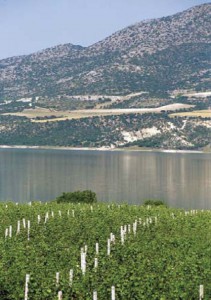 The visit to the Wine Route of the Lakes continues to the picturesque town of Velvedo, which is situated 33 kilometres southeast of Kozani at the foot of Pieria mountain, next to Polifitos lake. The settlement has significant Byzantine and Laterbyzantine monuments and truly breathtaking views of Pieria mountain and the lake. Visitors can also visit the Castle of the neighbouring town Servia, as well as the town of Kozani with an interesting museum, library and market.
The visit to the Wine Route of the Lakes continues to the picturesque town of Velvedo, which is situated 33 kilometres southeast of Kozani at the foot of Pieria mountain, next to Polifitos lake. The settlement has significant Byzantine and Laterbyzantine monuments and truly breathtaking views of Pieria mountain and the lake. Visitors can also visit the Castle of the neighbouring town Servia, as well as the town of Kozani with an interesting museum, library and market.
Finally, the journey takes the adventurous traveler to distant Florina and Kastoria on the way south to the end of the route with stops at the towns of Grevena and Siatista.
Other places of interest worth a visit in the vinicultural route of the Lakes are:
– Vora’s Skiing Resort (Kaimaktsalan) and the traditional settlement of St. Athanassios
– The Aridaia Baths (Pozar)
– The city of Edessa
– Florina (zoo, museums, the Sakoulevas river)
– Vigla’s Skiing Resort
– Prespes lakes (Psarades, St. Ahillios, St.Germanos)
– Klisoura’s Monastery
– The prehistoric settlement of Dispilio and the museum in Dispilio
– Kastoria and the fossilised forest in Nostimo
– Kozani (museum, lanterns during the carnival festival)
Source: www.wineroads.gr
: Visitable Wineries: Remarkable visited sites
In ancient times, Mount Pangeon, famous for its gold and silver mines, was the centre of Dionysian worship. According to the legend, this is where god Dionysus was raised and got the horses of King Lycourgos drunk with local wine.
The Route of Dionysus starts at mount Pangeon, from the ancient city of Amphipolis, continuing at Kariani, ta Hatzigeorgiou Estate and at Kokkinohori, at Ktima Vivlia Chora and then by the seaside road to the city of Kavala. From there, it reaches Wine Art Estate in Microhori near Drama and Pavlidis Estate at Kokkinogia close to Prosotsani, 17 km west of Drama. The route continues west to the Prefecture of Serres and reaches the impressive Kerkini wetland. On the way back, it passes through Kavala and continues to the east up to Maronia in Thrace, finishing the trip at the eastern part of Greece in the town of Soufli.

 The estate is situated, near the village Kokkinogia (or 15-20 min by car).The first city the visitor comes across is Drama, built on the foot of Mount Falakro which the locals call “the mountain of flowers”. Sightseeing in the region is ideal for mountain and forest lovers. They will find: a ski center and four mountainous resorts, the Mara cave with multicolored stalactites and reflections, also the beautiful forest of Elati.
The estate is situated, near the village Kokkinogia (or 15-20 min by car).The first city the visitor comes across is Drama, built on the foot of Mount Falakro which the locals call “the mountain of flowers”. Sightseeing in the region is ideal for mountain and forest lovers. They will find: a ski center and four mountainous resorts, the Mara cave with multicolored stalactites and reflections, also the beautiful forest of Elati.
The road from Drama leading to Kavala comes across the archaeological site of Fillippi. The excavations at the site of the ancient city and at the sideskirts revealed traces of Via Egnatia, the famous Roman market, the well known ancient theatre and many other buildings. If he climbs higher, up the Mount Pangeon, the visitor will encounter the Byzantine monastery of Icosifinitsa with the Aheropiiti Icon of the Virgin Mary, where as if he heads toward the coast he will come to the beautiful panoramic city of Kavala with the famous Byzantine castle, the Walls, and its imposing aqueduct, the Kamares. The visitor can enjoy in nearby locations beautiful beaches and fresh fish at the fish taverns.

![]() The route continues towards Thrace. It crosses Xanthi, a beautiful, oriental city with modern buildings and shopping malls close to narrow streets and mansions. It continues near Vistonida, a vast lagoon which is famous around the world as a refuge for wild birds of the Mediterranean. It makes a stop at the picturesque port of Porto Lagos. Thus, the visitor has now reached the center of the Thrace region, at Rodopi with Maronia and the Homeric Ismaros, home of the Vin de Pays Ismarikos.
The route continues towards Thrace. It crosses Xanthi, a beautiful, oriental city with modern buildings and shopping malls close to narrow streets and mansions. It continues near Vistonida, a vast lagoon which is famous around the world as a refuge for wild birds of the Mediterranean. It makes a stop at the picturesque port of Porto Lagos. Thus, the visitor has now reached the center of the Thrace region, at Rodopi with Maronia and the Homeric Ismaros, home of the Vin de Pays Ismarikos.

 According to Homer in the Odyssey, clever Odysseus got the Cyclope drunk and thus he, as well as his companions were able to escape from the one-eyed monster. Today, the freshly planted vines are a sign of the recent efforts to revive and continue with the ancient wine producing tradition.
According to Homer in the Odyssey, clever Odysseus got the Cyclope drunk and thus he, as well as his companions were able to escape from the one-eyed monster. Today, the freshly planted vines are a sign of the recent efforts to revive and continue with the ancient wine producing tradition.
The journey moves further on to the north-eastern part of Greece passing from the city of Alexandroupoli, Feres and ending in Soufli, the town with the biggest silk-producing tradition.
Guests of the Wine Route of Dionysus, except wine of the region can visit many remarkable places of archaeological and naturalistic interest, which are:
· Amphipolis (archaeological site, museum)
· Philippi (archaeological site, museum)
· Alistrati Cave and Aggitis Canyon
· Maara Cave
· Falakro Ski Resort
· Aggitis River Cave
· Simida Forest of Mikromilia
· Elatia Forest
· Nestos River Delta
· Porto Lagos
· Thassos Island
· Avdira (archaeological and folklore museum, traditional settlement)
· Archaeological site on the coast of Xanthi
Source: www.wineroads.gr
: Visitable Wineries: Remarkable visited sites
The Wine Route of Halkidiki starts at Agios Pavlos, moves on to the Kassandra, Sithonia and Mount Athos peninsulas and crosses the mountainous areas of Halkidiki, stoping at Arnea, before reaching the sea at the resort of Olimpiada in the east.
 The peninsula of Halkidiki lies ahead with its three branches that sink into the Aegean sea, the peninsulas Cassandra, Sithonia and Athos. The vines are cultivated in the central Halkidiki area (Agios Pavlos – Nea Kallikratia), at the middle branch, Sithonia and at the eastern one, Mount Athos. At Agios Pavlos the vineyards are spread in low hills. They abut on the sea which counterpoises with its aura the extreme summer temperatures. The varieties cultivated are Roditis, Sauvignon blanc, Xinomavro and Cabernet Sauvignon which produce the Vins de Pays de Halkidiki: a bright, fruity, vivid white wine and a deep colored, rich and round red.Continuing along their way, visitors should not neglect to visit the Petralona cave, where the skeleton of the most ancient man in Europe was found, the Archantrope, who lived there 700.000 years ago. Visitors will enjoy fresh fish and delicious sea food at the taverns in the nearby sea resorts.
The peninsula of Halkidiki lies ahead with its three branches that sink into the Aegean sea, the peninsulas Cassandra, Sithonia and Athos. The vines are cultivated in the central Halkidiki area (Agios Pavlos – Nea Kallikratia), at the middle branch, Sithonia and at the eastern one, Mount Athos. At Agios Pavlos the vineyards are spread in low hills. They abut on the sea which counterpoises with its aura the extreme summer temperatures. The varieties cultivated are Roditis, Sauvignon blanc, Xinomavro and Cabernet Sauvignon which produce the Vins de Pays de Halkidiki: a bright, fruity, vivid white wine and a deep colored, rich and round red.Continuing along their way, visitors should not neglect to visit the Petralona cave, where the skeleton of the most ancient man in Europe was found, the Archantrope, who lived there 700.000 years ago. Visitors will enjoy fresh fish and delicious sea food at the taverns in the nearby sea resorts.
 Sithonia, the middle peninsula of Halkidiki, is filled with picturesque small ports, sand beaches, verdurous landscapes and offshore settlements. The vineyards are located at Porto Carras, on the sunny slopes of Mount Meliton. The region’s dry climate and the beneficial moisture of the sea are in favor of producing selected wines. The red, deep colored, velvety tasted wine SLOPES OF MELITON (Appellation of Origin) which is produced through the combination of the Limnio, a variety known at least since the times of Aristotle and the French varieties Cabernet Sauvignon and Cabernet franc. A white wine of a pleasant freshness SLOPES OF MELITON (Appellation of Origin) is produced by combining three Greek grape varieties: Roditis, Assyrtiko and Athiri.
Sithonia, the middle peninsula of Halkidiki, is filled with picturesque small ports, sand beaches, verdurous landscapes and offshore settlements. The vineyards are located at Porto Carras, on the sunny slopes of Mount Meliton. The region’s dry climate and the beneficial moisture of the sea are in favor of producing selected wines. The red, deep colored, velvety tasted wine SLOPES OF MELITON (Appellation of Origin) which is produced through the combination of the Limnio, a variety known at least since the times of Aristotle and the French varieties Cabernet Sauvignon and Cabernet franc. A white wine of a pleasant freshness SLOPES OF MELITON (Appellation of Origin) is produced by combining three Greek grape varieties: Roditis, Assyrtiko and Athiri.
![]() Visitors will encounter crystal waters, golf and tennis courts, horses for horse riding, mountain bikes, yatchs for sailing and water sports facilities. Worth visiting is Parthenonas, a beautiful mountainous village which was abandoned from its inhabitants during the seventies but is reborn nowadays from the pioneers who have bought and restored its stone houses showing preference to the mountain’s healthy climate, quietness and magnificent view. Then again, at Neos Marmaras, visitors will come across many fish taverns that lie down their carreaux tablecloths on the sand almost reaching the waves, serving deliciously grilled fish and refreshing wine.
Visitors will encounter crystal waters, golf and tennis courts, horses for horse riding, mountain bikes, yatchs for sailing and water sports facilities. Worth visiting is Parthenonas, a beautiful mountainous village which was abandoned from its inhabitants during the seventies but is reborn nowadays from the pioneers who have bought and restored its stone houses showing preference to the mountain’s healthy climate, quietness and magnificent view. Then again, at Neos Marmaras, visitors will come across many fish taverns that lie down their carreaux tablecloths on the sand almost reaching the waves, serving deliciously grilled fish and refreshing wine.
 At the eastern peninsula of Halkidiki lies Mount Athos. There is a long lasting wine making tradition in almost all the monasteries of Mount Athos. Today, there is a wide variety of grapes cultivated at the vineyard: Roditis, Athiri, Assyrtiko, Limnio, Xinomavro, Cabernet Sauvignon and Grenache rouge. In this blessed land with the mild climate, the efficient sunlight, the mountainous freshness and sea moisture are produced two Vin de Pays Agioritikos, a pleasant fresh white and a fruity rose. The Chromitsa Vineyard by Tsantalis Winery and the Mylopotamos Winery are the wineries – members of the Wine Producers Association.
At the eastern peninsula of Halkidiki lies Mount Athos. There is a long lasting wine making tradition in almost all the monasteries of Mount Athos. Today, there is a wide variety of grapes cultivated at the vineyard: Roditis, Athiri, Assyrtiko, Limnio, Xinomavro, Cabernet Sauvignon and Grenache rouge. In this blessed land with the mild climate, the efficient sunlight, the mountainous freshness and sea moisture are produced two Vin de Pays Agioritikos, a pleasant fresh white and a fruity rose. The Chromitsa Vineyard by Tsantalis Winery and the Mylopotamos Winery are the wineries – members of the Wine Producers Association.
 Further north, in the picturesque town of Arnea, the brand new winery of Claudia Papagianni awaits wine lovers for a tour of the wine making facilities. The route then passes through traditional mountainous villages, makes a stop at ancient Stagira, birthplace of Aristotle and ends at Olimpiada, a beautiful seaside resort.
Further north, in the picturesque town of Arnea, the brand new winery of Claudia Papagianni awaits wine lovers for a tour of the wine making facilities. The route then passes through traditional mountainous villages, makes a stop at ancient Stagira, birthplace of Aristotle and ends at Olimpiada, a beautiful seaside resort.
Along the route, there are countless inns, restaurants, tavernas, local produce and outdoor activities businesses providing top-quality options for demanding travelers. Finally, the tour of Halkidiki is not complete without a visit to the following places of archeological and tourist interest:
– Archeological Museum of Poligiros
– Ancient Stagira
– Toroni Castle
– Arnea
– Rentina Castle
– Ierissos
– Kalithea
– Ouranoupoli
– Visit to the Mount Athos monasteries
– Tour of Mount Athos by boat
Source: www.wineroads.gr
: Visitable Wineries: Remarkable visited sites

